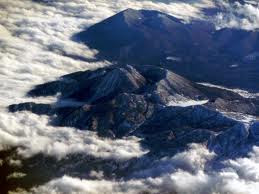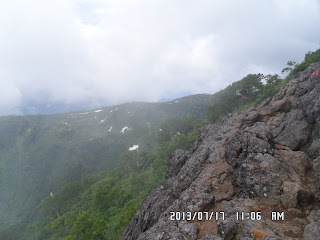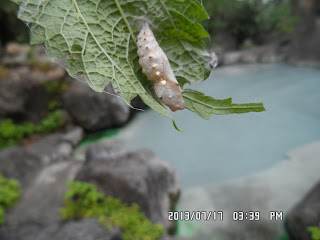Mountain: Mount Myōkō (妙高山 Myōkō-san) is an active stratovolcano in Honshu, Japan. It is situated at the southwest of Myōkō city, Niigata Prefecture, and a part of Joshinetsu Kogen National Park.
Mount Myōkō is listed as one of 100 Famous Japanese Mountains, and together with Mount Yahiko (弥彦山 Yahiko-yama), it is well known as the "famous mountain" of Niigata Prefecture.
Hiking Date: July 17 (Wed) 2013, Cloudy, then rain.
Hiking Course: Seki-onsen (Mr. S’ car) -> Tsubame-onsen – Myosen Bridge – Asadaira Branch – Chinoike – Yumichi Branch – Munatsuki Hacho – Tengudo – Fu-ketsu (Wind Hole) – Kusariba (Chain Field) – The sumit of Mt. Myoko ----Yumichi Branchi – Ogon-no Yu (Golden Spa) – Tsubame-onsen (Mr. S’ car) -> JR Sekiyama ST
Public Transportation for return trip: JR Sekiyama – (Shinetsu Line) – Nagano – (Shinkansen) – Tokyo – (Tokaido Line) – Ofuna
Hiking Partner: Mr. S (my old classmate at NTT College in late 1970s who lives in Takaoka, Toyama Prefecture)
We got up at 4:30 and had breakfast in our hotel room. We checked out at 5:25 am.
Mr. S drove from Seki-onsen to Tsubame-onsen where the trail to Mt. Myoko started. Tsubame-onsen seemed a little village of hot-spring inns with many beautiful flowers.
We went through the village and parked just at the entrance of the trail to Mt. Myoko.
After taking pictures at the entrance, we began climbing the mountain at 5:45 am. We soon came to a suspension bridge named “Myosen Bridge.”
However, the bridge was under construction and we had to walk down to the bottom of the valley and climbed up to the cliff by temporary stairs.
When we went through the woods and came to a ridge, we could see some towns in distance. Then I found precious plants; Monotropastrum humile or “Indian pipes.
http://en.wikipedia.org/wiki/Monotropastrum_humile
I saw these plants at Oze a couple of years ago. This time, I saw many of them and I felt very happy.
My hiking partner, Mr. S is a smoker. He carries a portable ashtray and whenever he takes a rest, he enjoys smoking.
So, I walked ahead, then waited for him. When he caught me up, then he started smoking and I began walking ahead. We repeated this pattern all the way to the summit, and then coming down to Tsubame onsen.
I arrived at Asadaira Branch (2nd ST) at 6:22, then Chinoike(血の池) or“The Blood Pond” of altitude 1,500m at 7 am.
I guess the origin of “Blood Pond” came from the color of the stream; muddy red because of volcanic mineral in the water. (The water was warm.)
The next spot was “Yumichi Branch.” Here, “Yumichi(湯道)” means the streams of hot-water, so obviously the stream is hot-spring water. I arrived there at 7:38.
The next point was on the 5th ST of the mountain and called “Munatsuki Haccho” which means the steepest part of the climbing trail. The altitude was 1800m.
We saw snow in the valley there. We had to walk across the snow. It was 8:18 am.
There was a wood of white birches. When I went through the wood, then I came to “Tengudo” which was the 6th ST of the mountain (1,930m.)
In front of Tengudo shrine, there was an open space. I peeled apples while waiting for Mr. S. We shared the fruit when he arrived at the 6th ST.
When I arrived at the 7th ST, there was a shallow pond named "Kozenji-ike光前寺池." I wondered if there was a temple called "Kozenji." However, there was no facility to sit there, neither any open space, so I went on without waiting for Mr. S.
I arrived at the 7th Station of altitude 2,070m at 9:18. I did not wait for Mr. S there, but went on to “Kaza-ana” or “Wind Cave” which was the 8th ST of 2,120m.
There was two small wind holes at “Fu-ketsu” and cool wind came from these caves. I waited for Mr. S while having a rice-ball.
Above 2000 meter altitude, I saw many alpine flowers there and there. When Mr. S arrived at Kaza-ana he also liked the place very much.
When I went on to the 9th ST where there was “Chain Field.” It reminded me of the similar place near the summit of Mt. Ishizuchi(石鎚山) in Shikoku.
I remembered that hiking with Bernardo of Mexcico and Mt. Matsumoto from Kyushu in Oct. 2010.
It was cloudy that day, but when I came to the 9th ST, I could see other mountains, esp. Mount Hiuchi (火打山 Hiuchi-yama) in front of me.
When I climbed up to the top of the cliff at Chain Field, it was close to the summit, yet had to walk through rocky place for about 50 meters.
The rocks are consolidated lava, similar to Mt. Fuji. But I could see alpine flowers even on the consolidated lava rocks.
We arrived at the summit of Mt. Myoko (2,454m) at 11:15. There were shrines on the top of the mountain, and I saw a strange “Jizo” which was completely different from ordinary “Jizo.”
It looked like a general on the back of horse, and it is called “Shogun Jizo.” Actually it was "Myoko-Daimyojin(妙高大明神)." It is a combination of Shintoism and Buddhism, because "Daimyojin" is a term of Shintoism and Jizo is supposed to be a term of Buddhism as "Ksitigarbha." It was built during World War Two for the prayer of the victory.
Mr. S brought canned “mikan” or mandarin oranges. It tasted very good. We had 30 minute rest for lunch and began descending the mountain at 11:50 am.
We saw a woman hiker coming up when we began descending. Her walking pace was much faster than us. When I was walkd down after “Yumichi Branch” she passed over me.
Later, Mr. S told me that he enjoyed talking with her for more than 10 mintes. They seemed to have common topics of the local area. I was amazed at Mr. S’ sociability.
Anyhow, I waited for Mr. S at Yumichi Branch, and decided to go down first and to wait for him at “Ogon-no-yu黄金の湯” or “Golden Spa” while enjoying the spa.
I arrived at “Ogon-no-yu黄金の湯” at 3:10 pm. It is a public open-air hot-spring, and to my surprise, free of charge.
Since it was free of charge, it seems nobody clean the spa. The hot water itself is clean, because it continuously spring up from the earth. But the rocky bath-tub was full of moss, and slippery. So, you must be careful to go into the spa.
It was not a coed style, the bathing place for men and women were different.
I found a cast‐off skin of a snake on the rock which separates spa for men and women. It was about 1.2 meter. I also find a pupa of a butterfly. It was silver color and shining.
Japanese people generally like a cast-off skin of a snake, because it is believed that if you put it (even a part of it) into your purse or wallet, you get more money. I guess it comes from "rebirth" ability of snake. However, I do not believe that and I left it as it was.
Mt. S arrived at the spa at 3:30 pm. We still had enough time for him to enjoy the spa.
We left the spa at 3:45 and hurried to JR Sekiyama Station. Mr. S sent me off at the station and I took a train at 4:20 pm.
Just before the train arrived, it began raining. I am very much thankful to my God that He allowed us to climb Mt. Myoko safely, without rain.
On the way back, I took “Nagano Shinkansen” which brought me to Tokyo very fast.
It was raining in Kanto area, but I could come back to Ofuna without getting wet at all.
----------------------------------------------------------------------------------------------------
分類:登山、日本、東北・上信越, 日本百名山(Best 100 Mountains in Japan)
登山日:2013年7月17日(水)曇りのち雨
登山目的地:上信越高原国立公園の妙高山(2,454m)
登山コース:関温泉「泉山」→燕温泉登山口~妙仙橋~麻平分岐(二合目)~血の池(三合目)~湯道分岐~胸突き八丁(五合目)~天狗堂(六合目)~風穴(八合目)~鎖場(九合目)~妙高山山頂~湯道分岐~黄金の湯(無料露天風呂)~燕温泉登山口
復路の交通機関:JR関山駅→ (信越本線) → 長野 →(新幹線)→ 東京 → (東海道線) → 大船
パートナー:前夜宿泊した「泉仙」から帰路のJR関山駅までS氏、関山から大船までの帰路は単独旅行。
朝4時半に起床。5時に前日コンビニなどで購入した朝食を食べ、5時25分には旅館を出た。
S氏の乗用車で燕温泉郷へ向かった。燕温泉郷は小規模な温泉郷でバス停の周りにはきれいな花が多く咲いていた。
我々はバス停からさらに上部の旅館街を抜けて、登山口直近の駐車場に車を停めた。
燕温泉登山口で認証写真を撮って登山開始したのは5時45分。歩き始めて10分ほどで渓谷に架かる「妙仙橋」に出た。
この橋は工事中で、渓谷まで下って上る迂回路を通った。対岸へ渡ってからが本格登山の開始だ。
[A lot of ferns, シダ類の植物、양치류 식물]
開けた場所に出ると遠くの町や山々が見える。足元の植物で最初に目についたのは尾瀬で見た「ギンリュウソウ(銀竜草)別名『ユウレイタケ』」だ。
尾瀬では二、三カ所しか見なかった「ギンリュウソウ」だが、今回は大小さまざまなサイズで実によく目にした。
パートナーのS氏はタバコ休憩をするため、キーポイントに着くたびに彼を待ち、彼がタバコを吸っている間に私が先行するパターンを繰り返した。
二合目の「麻平分岐」には6:22に到着。標高1,500mの三合目の「血の池」には7時に到着した。
「血の池」の由来はおそらく温泉の成分の影響で岩が赤いためだろう。
30分ほど進んだ「湯道分岐」には7時38分に到着。
次のポイントの五合目「胸突き八丁」の標高は1800mで残雪の雪渓を登らなければならない。「胸突き八丁」到着時刻は8時18分。
このあたりは時々、陽が探し白樺の林は明るい。標高1930mの六合目「天狗堂」には8時52分についた。
天狗堂の前はかなりひらけていて、S氏を待つ間に持参したフルーツを切った。
標高2070mの七合目には9:18に到着。ここ光善寺池という池があったが、休める広いスペースもなかったので、S氏を待たずに先に進み、標高2120mの八合目「風穴」には9:36についた。
ここの山の壁面には風穴が空いていて、涼しい風が穴から出ている。ここでは握り飯を食べながらS氏を待った。
このあたりから高山植物が多く目につく。風穴はS氏も気に入って、共に約10分休憩した。
標高2,260mの九合目「鎖場」には10:17に到着。ここでもS氏が大幅に遅れ、彼を待つ間に握り飯などを食べた。
また、この鎖場は見晴らしが良く、ちょうど雲の合間から峰々が見えた。特に近くに見えたのは隣接する日本百名山の1つである「火打ち山」である。
鎖場を登り始めたのは10:42。ベルナルドや松本さんと登った四国の石鎚山の頂上付近を思い出した。
だが、妙高は石鎚と違って登り切ってからさらに岩場を登らなければならない。
この頃、雲がやや切れて展望が開けた。また岩場に咲く小さな高山植物がかわいいし、きれいだった。
また妙高に向き合った火打山の一部の雪渓なども見えた。鎖場を登り切った先には岩場の展望台のような場所があり、その先が溶岩が固まったそのままのような妙高の頂上だ。
標高2454mの十合目の標識に着いたのは11:15。足元の丸い銅製の標識には「妙高大明神」とあり、「ここは標高2,454m」とあった。また、この胸式では、東西南北の方向が記されていた。
頂上には一風変わった乗馬姿の「将軍地蔵」が祭られていたが、どうもこれが「妙高大明神」らしい。そうだとすると、これは明らかに神仏混合である。なぜなら「地蔵」は仏教の「地蔵菩薩」だし、「大明神」の神道の神だからだ。読みにくい石の碑文を読むと「大東亜戦争の必勝を祈念して神を祭る」となっているので、第二次世界大戦中に建立されたものらしい。
頂上ではS氏が持参したミカンの缶詰をごちそうになった。頂上では約30分休憩し11:50に下山開始した。
頂上から鎖場へ下る途中、地元関山の女性ハイカーと会った。S氏はこの女性ハイカーとかなり長く話をしたそうで、彼の社交性に感心した。
この女性は我々よりかなり早いスピードで登山していて、頂上到達後、すぐに下山を開始し、S氏を追い越して、私は燕温泉の源泉付近で追い抜かれた。
私は往路で左足が攣り、やや痛む足で登頂したが、下山の鎖場への岩場では両足が攣った。
五合目の胸先八丁の下は雪渓で、この上を歩く時はアイゼンもないので注意を要した。
しかしこの程度の筋肉痛は何度も経験済みなので慌てずに下山を続けた。
S氏は私よりさらに遅れ気味で、「湯道分岐」で彼を待った後、往路とは別の登山路を下り、「黄金の湯」で彼を待つことにした。
「黄金の湯」は、いまどき珍しい無料露天風呂(有志がお金を置く箱はある)で、私が付いたのは3時10分。
S氏は3時30分に到着した。「黄金の湯」は畳2畳ほどの露天風呂男女別になっていて、湯の流れ口の石はみごとな緑色だった。
男湯の方の石には1.2mほどのヘビの抜け殻があった。また、そばの草には蝶々のきれいなさなぎがあった。日本ではヘビの抜け殻を財布に入れておくと金が入るという迷信があるが、これはヘビの再生力からくるものかもしれない。いずれにせよ、私は抜け殻をそのままにしておいた。
再生と言えば、まるで死んだようになったさなぎが、時が来れば開いて中から美しい蝶が誕生するほうが、より神秘的な感じがする。このきれいなさなぎはどんなチョウになるのだろうか。
風呂は午後3:45に切り上げ、駐車場に戻って関山駅へ向かった。
途中、昨日「笹寿司」を買った生協に寄り夕食用の「笹寿司」と土産用に「野沢菜」を買った。
S氏とは関山駅で午後4:20に再会を誓って別れ、午後4:28の信越線に乗った。
長野到着が大幅に遅れ新幹線の発車時刻ぎりぎりになった。長野駅から先は雨が本降りで関東地方も雨だった。
妙高登山中に雨にならなかったことを、そして無事に下山できたことを神に感謝した。
I like hiking very much. I used to go hiking with a Korean hiking club named “AhToSan.” This blog introduces mostly my hiking activities in Korea and Japan, and Sydney in Australia. As of January 2020, I live in Sydney suburb. I go Blue Mountains and bush walk in Sydney area. 私は2003年から2014年まで韓国の大田(テジョン)に住んだ日本人である。11年間、週末は主に「アトサン山岳会」に参加した。14年4月に帰国したが、2020年以降はおもにシドニーで暮らし、時折、日本へ帰国する程度である。したがって最近の記事はSR(Sydney Report)としてブルーマウンテンのトレッキングを中心に書いている。
About pictures/当ブログ内の写真について/당 블로그내의 사진에 대해서
Most of the pictures in this blog are taken by my camera, yet some of them were downloaded from the website of the hiking club. If you click any pictures, they become the original size.
当ブログ内の写真の大部分は筆者のカメラで撮影したものですが、一部、山岳会の共有写真からダウンロードしたものを含みます。すべて、各写真をクリックすれば、元のサイズに拡大します。
당 블로그내 사진의 대부분은 필자의 카메라로 촬영한 것입니다만 일부 산악회 공유 사진으로부터 다운한 것도 포함합니다. 모두 각 사진을 클릭하면, 원래 사이즈에 확대합니다.
当ブログ内の写真の大部分は筆者のカメラで撮影したものですが、一部、山岳会の共有写真からダウンロードしたものを含みます。すべて、各写真をクリックすれば、元のサイズに拡大します。
당 블로그내 사진의 대부분은 필자의 카메라로 촬영한 것입니다만 일부 산악회 공유 사진으로부터 다운한 것도 포함합니다. 모두 각 사진을 클릭하면, 원래 사이즈에 확대합니다.
登録:
コメントの投稿 (Atom)





























































































































Its a very informative post, i read it a found new useful stuff that is very useful for me...
返信削除Bigrock Web Hosting Company Reviews
Fatcow Web Hosting Company Reviews
Bluehost Web Hosting Company Reviews
Thanks for visiting my blog.
返信削除